Serendip is an independent site partnering with faculty at multiple colleges and universities around the world. Happy exploring!
BSIE 2010: Session 11

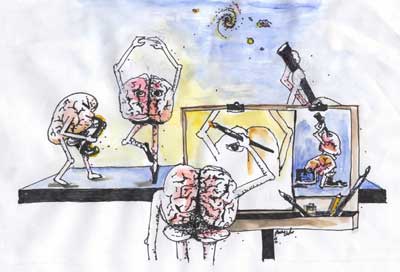 |
Brain, Science, and Inquiry-Based Education
|
 |
The Brain as a Distributed System, and a Second Loop
Picking up from yesterday
Our brain is very different from one another and the brain is always in a process of changing. We tend to learn more when we are active and engaged learners. That's why as a teacher it is important to put our maxiumum effort to make the student active ... Shoshana
if enough people walked on a certain area of grass, a new path will be form. The brain forms new pathways with different experiences/thoughts/inputs. The pathway becomes "stronger" with the repetition of these experiences/thoughts/inputs" ... Regina Toscani
The brain as an empirical inquirer - Loop 1
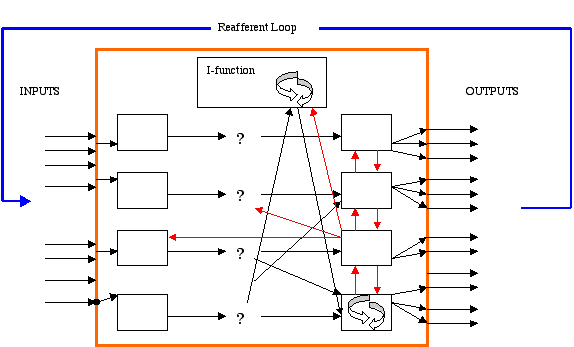
An ongoing conversation between the brain and the outside world involving
Learning from difference ("conflict") between expectation and input "Keeping students in vacillating state of equilibrium" ... Joyce Going on all the time, largely unconscious ("without thinking"), beginning at birth How Babies Think, Alison Gopnick, Scientific American, July 2010 Active learning more effective than passive learning (eg sudoku) |
The "real" nervous system - an input/output box consisting of interconnected input/output boxes?
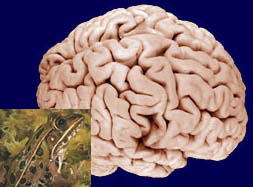 |
 |
| photo from Kemali and Braitenberg, Atlas of the Frog Brain, Springer-Verlag, 1969 |
Caudal to rostral sequence of "boxes" of "central nervous system" originates in neural tube development, is commmon to all vertebrates
(will defer to later discussion of invertebrates, variations among vertebrates)
Each box in turn (somewhat arbitrarily) subdividable into smaller boxes (with some differences among vertebrates, to return to)
And those ... yes, "its boxes all the way down"


The smallest box: neurons everywhere
Invertebrate nervous systems also have neurons, but differently arranged - makes sense?
Neuron as common, smallest box and as input/output element, connected to other boxes
- Cells, like other cells, but specialized to receive/process transmit "information" (as opposed to matter or energy)
- Size scale - tens of microns (10-6) meters)
- Larger boxes must differ in how smallest interconnected
- Relevance of numbers? enough to "account for all the uniqueness that exists among people"? ... 1012exp1012 possible nervous systems?
- Differences between people, differences between organisms due to .... not building blocks but assembly (architecture)
- Need to know how neurons work - to return to
Can use boxes->boxes ... ->boxes(neurons) to show that larger boxes interconnected, in relatively specific ways (anatomical specificity) and to rigorously specify "input" and "outputs" of largest box ... nervous system itself
- grey matter (soma, dendrites, pre-synaptic terminals, neuropil) vs white matter (bundles of axons, tracts)
- central vs peripheral nervous system (some ganglia, but largely axon bundles
- output elements of nervous system (motoneurons, plus) = neurons with axon terminating outside nervous system
- input elements of nervous system (sensory neurons, plus) = neurons with receiving surface (dendrites) outside of nervous system
- everything else = interneurons
- numbers/proportions: more reason to think of ns as "semi-autonomous"
So ... at least parts of our box within box model real ... and helps define "input" and "output" more rigorously
Implies: different regions on brain, different brains, different behaviors largely because of different assemblies of similar elements ("architecture")
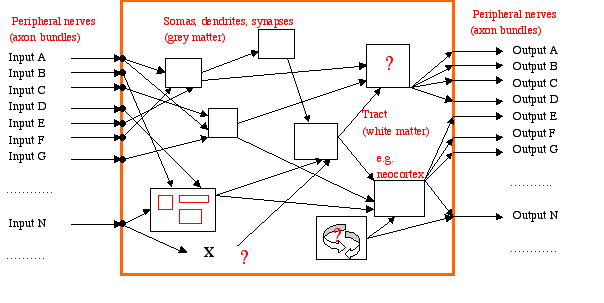
Topographic organization - anatomical specificity (input and output locations)
Outputs - (myotomes)
- Motoneurons located at levels of neuraxis related to location of muscles controlled
- Each motoneuron activates only one muscle
- Implications:
- "action" is not one output but pattern of activity across lots of them - "motor symphony"
- source of lots of additional variation in behavior
- lots of outputs/nervous system involved in any "action", is "distributed" characteristic
- need to understand how patterns of activity created, parts coordinated
Inputs - (dermatomes)
- Sensory neurons terminate at levels of neuraxis related to location of receptors
- Implications
- "sensation"/"perception" not one input but pattern of activity across lots of them (across modalities and, as will be seen, in one modality - another "distributed" characteristic
- need to understand how inputs combined
- thought = pattern of activity across lots of neurons
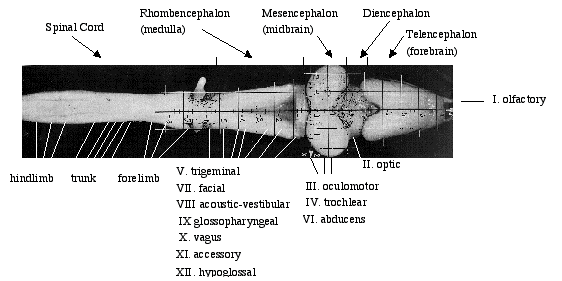 |
For additional information: |
Usefulness of the interconnected box model and ... another box?
- Capabilities of spinal cord
- Quadriplegia (slightly better) - relevance of topographic organization
- Christopher Reeves and ... , from NIH
- The "I-function"
Observations "surprising", but have to be accepted - Issue is "how to make sense of them"
Two kinds of behavior ("reflex" versus something-else) intuition probably not useful
- Spinal cord capable of very sophisticated activity
- Brain capable of quite unsophisticated activity
- Distinction between "reflex" and other things?
- "foot withdraws when irritated" - spinal cord capable of sophisticated activity on own
- is ok ... given topography and "physical contiguity principle ("PCP")
- "person doesn't say ouch when foot irritated" - behavior frequently depends on linking paths within nervous system
- is ok ... given topography and "physical contiguity principle ("PCP")
- "person doesn't move foot when hearing (or reading) request to do so" - behavior frequently depends on linking paths within nervous system
- is ok ... given topography and "physical contiguity principle ("PCP")
- "person says foot irritation not felt/experienced" - behavior frequently depends on linking paths within nervous system
- is ok ... given topography and "physical contiguity principle ("PCP") AND ..
- "behavior" can occur without it being experienced by the behaving organism AND ...
- neuronal circuitry adequate to support "feeling/experiencing" (I-function) is in the brain (spinal cord not needed for this function)
- Where is Christopher Reeves? Is he paralyzed? Does he feel pain? - has to do with "mind", "self", "soul", "personality", "consciousness" ?
- words requiring redefinition in light of new experiences/observations?
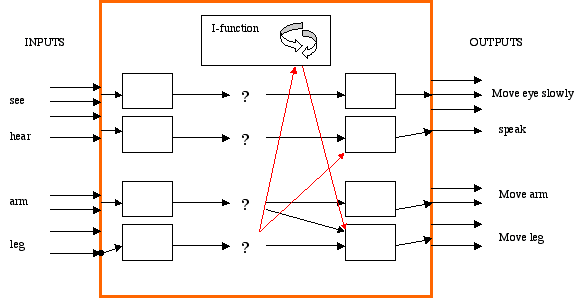 |
Ascending somatosensory pathways Descending motor pathways
|
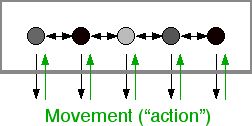
Brain a distributed system, works by interaction/conversation among boxes
|
No one in charge, non-hierarchical, coordination by conversation
Multiple selves is a feature of all of us
|
The bipartite brain and a second loop (conversation between unconscious and conscious, "reflection")
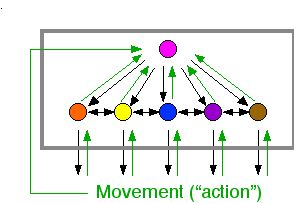
Uncovering the cognitive unconscious - an informed guesser, observations as constructions
Reflection - learning to use a conversation between the cognitive unconscious and the I-function, story teller
Being skeptical, being creative



Comments
Getting Rid of Expectations
It sounds close to impossible--and it very well may be--but the education system could use an extreme makeover. Our classrooms are burdened with too many expectations. Teachers are expected to get through a set curriculum in a matter of months; students are expected to pass standardized tests, get good grades and "succeed" using the knowledge they absorb in school. I've often wondered what would happen if we completely rid the system numerical expectations such as grades. Without grades, students cannot be judged on a mass scale (whether by teachers who quickly glance at a gradebook and make a hasty decision based on what they see, or future employers leafing through applications). A gradeless world would force my personal interaction between such teachers/employers and students, as this would be the only way for a person to be evaluated individually. Classroom dynamics might become more equalized, as there would be no "grade pyramid" with those students thought to be the "smartest" on top. And, of course, students might be more willing to try new things out ("thought experiments?") without expecting an outcome or "right answer" if they knew they would have the opportunity to explain their thought process--rather than just being judged by a number on a piece of paper. Numbers cannot possibly signify the depth of a child's learning, as they are anything but "custom fit" and reflect the ideals of a society shaped by all kinds of forces. But how are we to possibly fix the system when it relies so heavily on grades at the current time? Are we addicted to putting a number on intelligence and judging our students accordingly?
Classroom Learning
Learning must take place in a "classroom." A classroom does not need four walls. It does not have to be located within a building. The teacher does not have to be a trained professional. The "classroom" is wherever the learner happens to be at any given moment. Sometimes the classroom has a designated teacher/facillitator/conductor. At other times, there is no designated conductor. Instead there is co-constructive dialogue taking place (and this may be conscious or unconscious.) Sometimes the learner, or others, may not realize that learning has taken place until there is a need to perform or demonstrate.
Reflections on Co-constructive Dialogue
Co-constructive dialogue is a powerful tool to expand the perspective of each person involved in a joint conversation. For the last week, the participants in this Institute have shared ideas based on the questions posed by Paul. We have not always agreed, but each of us has had the opportunity to test our ideas and incorporate the input from the others as they responded to our output. Not only have we responded to Paul's output as facilitator, but often we have moved beyond Paul's original question to questions generated by one another. My Middle School students would call this a diversion. They love these discussions and get quite excited when I say we will take the time to follow one. You can see the engagement lighting up their faces. Their interest level is high, and if I can facilitate the flow of the discussion, we can usually get back to where we need to be in order for them to manage their homework assignment. If I can't get the group back to where we need to be, I will use a segue that makes them laugh or groan. The humor helps to keep them engaged as they wait to see how I will reroute the conversation. Most importantly, they have had the opportunity to express thoughts on a topic one among them has chosen, and they feel valued as so many in the class have related their individual experience on the topic. This takes patience. Remember these are 12 year olds in a biology class. We will be regaled with surgeries, illnesses, accidents and the like that have impacted them and close and distant relatives, friends, and characters in movies and TV shows. For me as teacher, it is an important opportunity to understand my students and how they are processing the information of the course. There are times when they share an experience that gives me the chance to find a bond with them. For them, it is the necessary output that stimulates a response from me to their specific idea while also creating links with other students who share similar experiences. These are the days when the students don't want to leave class. They dawdle until I have to shoo them to the next class with notes of apology to their teachers.
Yes, Paul, co-constructive dialogue works for students as well as adults. Engaging in the conversation at these Institutes reminds me to make more time for the shared dialogue with my students. I enjoy it immensely, and so do they.
One cautionary note. There are days when I feel that I have to be the conductor in the classroom. Therefore, I find myself advocating for a balance between inputing basic information, technical vocabulary, and chemical processes to develop a common classroom language and initiating co-constructive conversation to develop a share summary of observations among myself and the students in my classroom.
INPUT
I liked the notion of success being reached by trying things out without knowing whether they will work or not. This idea also ties into the notion of students being uninhibited in the classroom and feeling free to experiment. I'm very familiar with working this way since theatre and drama involve experimentation and getting things wrong without the burden of feeling embarrased or being made fun of. It's all about observing and making new observations as we go along.
Learning
Everyone can learn, and the classroom is not the only place where students can learn. Some people learn better in different environments, and the teacher needs to find a way to make each student successful by customizing their learning experience. Sometimes the environmet outside the classroom is just as important as the one within it.
Learning is a process of trying new things and seeing if they work. If they don't work, you must try out another idea and reshape your observations. It is important for students to feel successful, even if they don't understand all the material.
Post new comment